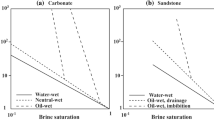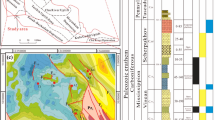Abstract
Wettability plays a pivotal role in oil recovery processes in reservoirs owing to the fact that it has a direct impact on the proportion of oil recovery. Reservoir rocks are a complex of a variety of mineral types, and each mineral may have a different wettability. Typically most aquifer materials such as quartz, carbonate, and dolomite are water-wet prior to oil migration. Some oil recovery processes are designed to alter the wetting preference of the oil formation to be more oil-wet. There are three techniques used in the laboratory for the characterization of the capillary pressure properties of core samples: mercury injection, centrifuge, and porous plate. This article provides an in-depth review of wettability. It also entails a case study from one of the Iranian carbonate reservoirs and measurements, which have been carried out for selected samples to clarify the nature of the wettability of reservoir rock. Samples were chosen from three wells of oil field which is composed of limestones and dolomites, rarely inter-bedded by shales, and their wettability was measured by Amott–Harvey method, which is one of the main methods for measuring wettability. After cleaning and drying the samples, measurements were carried out. According to the results, it can be said that the range of Amott–Harvey index for these samples is between −0.48 and −0.8. In Amott–Harvey method, if IAH varies from −1 to −0.3, the rock is oil-wet. Therefore, it can be concluded that the reservoir is oil-wet.














Similar content being viewed by others
References
Amott, E. (1959). Observations relating to the wettability of porous rock. In Petroleum Transactions, AIME, Vol. 216, pp. 156–162, Oct. 16–17, 1958.
Austad, T., Matre, B., Milter, J., Saevareid, A., & Øyno, L. (1998). Chemical flooding of oil reservoirs and Spontaneous oil expulsion from oil-and water-wet low permeable chalk material by imbibition of aqueous surfactant solutions. Colloids and Surfaces A: Physicochemical and Engineering Aspects, 137(1), 117–129.
Craig, F. (1993). The reservoir engineering aspects of waterflooding: Monograph, Henry L. Doherty Series (Vol. 3). Dallas: Society of Petroleum Engineers.
Donaldson, E., Thomas, R. D., & Lorenz, P. B. (1969). Wettability determination and its effect on recovery efficiency. Bartlesville: Bureau of Mines.
Esfahani, M. R., & Haghighi, M. (2004). Wettability evaluation of Iranian carbonate formations. Journal of Petroleum Science and Engineering, 42(2), 257–265.
Graue, A., Aspenes, E., Bognø, T., Moe, R., & Ramsdal, J. (2002). Alteration of wettability and wettability heterogeneity. Journal of Petroleum Science and Engineering, 33(1), 3–17.
Green, D. W., & Willhite, G. P. (1998). Enhanced oil recovery: Richardson, Tex., Henry L. Doherty Memorial Fund of AIME. Dallas: Society of Petroleum Engineers.
Hirasaki, G. (1991). Wettability: Fundamentals and surface forces. SPE Formation Evaluation, 6(2), 217–226.
Jadhunandan, P., & Morrow, N. R. (1995). Effect of wettability on waterflood recovery for crude-oil/brine/rock systems. SPE Reservoir Engineering, 10(1), 40–46.
Jerauld, G., & Rathmell, J. (1997). Wettability and relative permeability of Prudhoe Bay: A case study in mixed wet reservoirs. SPE Reservoir Engineering, 12(01), 58–65.
Lu, J., Goudarzi, A., Chen, P., Kim, D. H., Delshad, M., Mohanty, K. K., et al. (2014). Enhanced oil recovery from high-temperature, high-salinity naturally fractured carbonate reservoirs by surfactant flood. Journal of Petroleum Science and Engineering, 124, 122–131.
Mohammed, M., & Babadagli, T. (2015). Wettability alteration: A comprehensive review of materials/methods and testing the selected ones on heavy-oil containing oil-wet systems. Advances in colloid and interface science, 220, 54–77.
Morrow, N. R. (1990). Wettability and its effect on oil recovery. Journal of Petroleum Technology, 42(12), 1476–1484.
Nawi Derahman, M., & Zahoor, M. (2008). Prediction and estimation of capillary pressure for wettability and wettability variations within reservoir. In Abu Dhabi International Petroleum Exhibition and Conference, 2008
Thomas, L., Dixon, T., Evans, C., & Vienot, M. (1987). Ekofisk waterflood pilot. Journal of Petroleum Technology, 39(2), 221–232
Author information
Authors and Affiliations
Corresponding author
Rights and permissions
About this article
Cite this article
Bakhshi, E., Torab, F.M. Determining Wettability of Fractured Carbonate Reservoirs. Nat Resour Res 25, 211–225 (2016). https://doi.org/10.1007/s11053-015-9282-z
Received:
Accepted:
Published:
Issue Date:
DOI: https://doi.org/10.1007/s11053-015-9282-z




